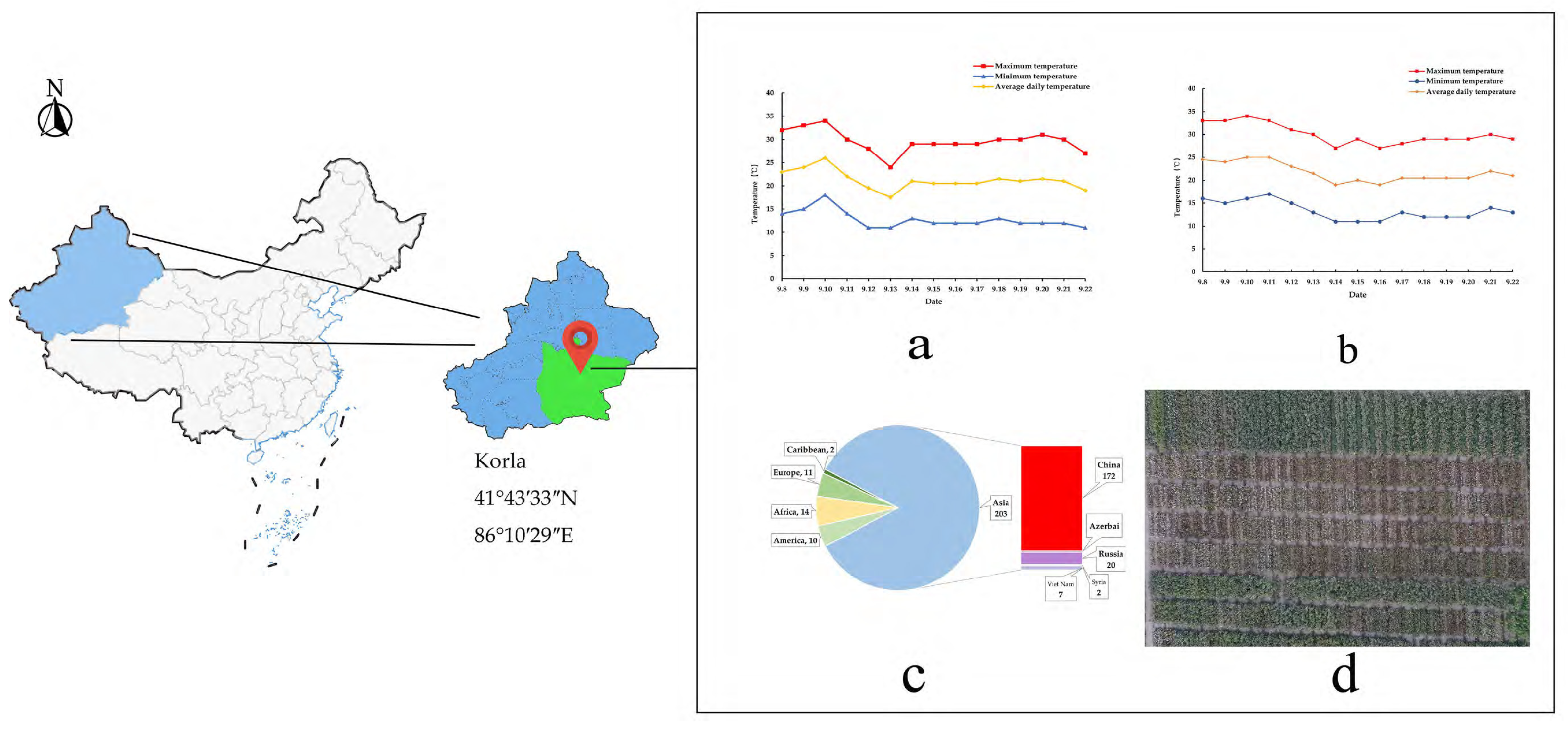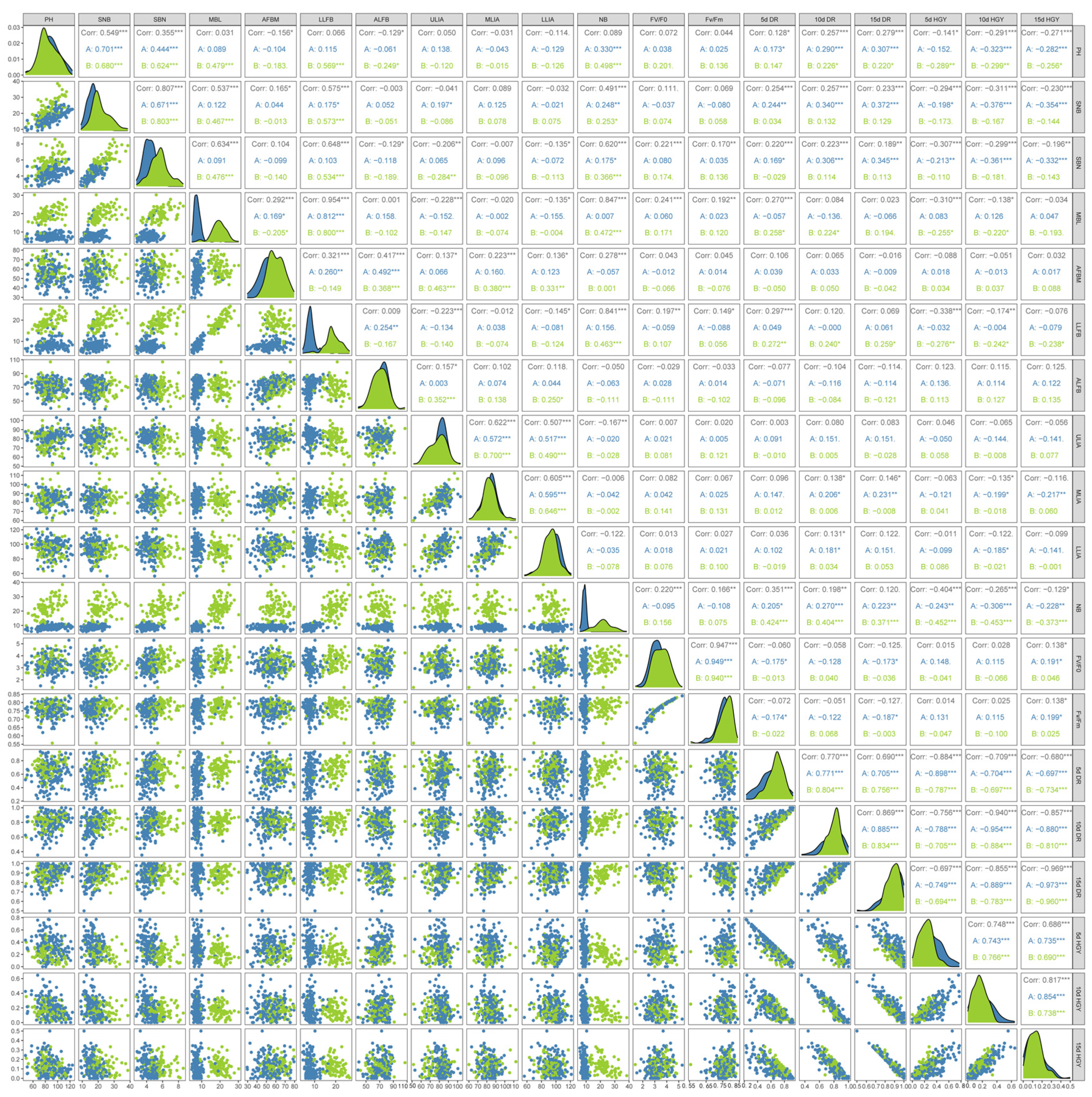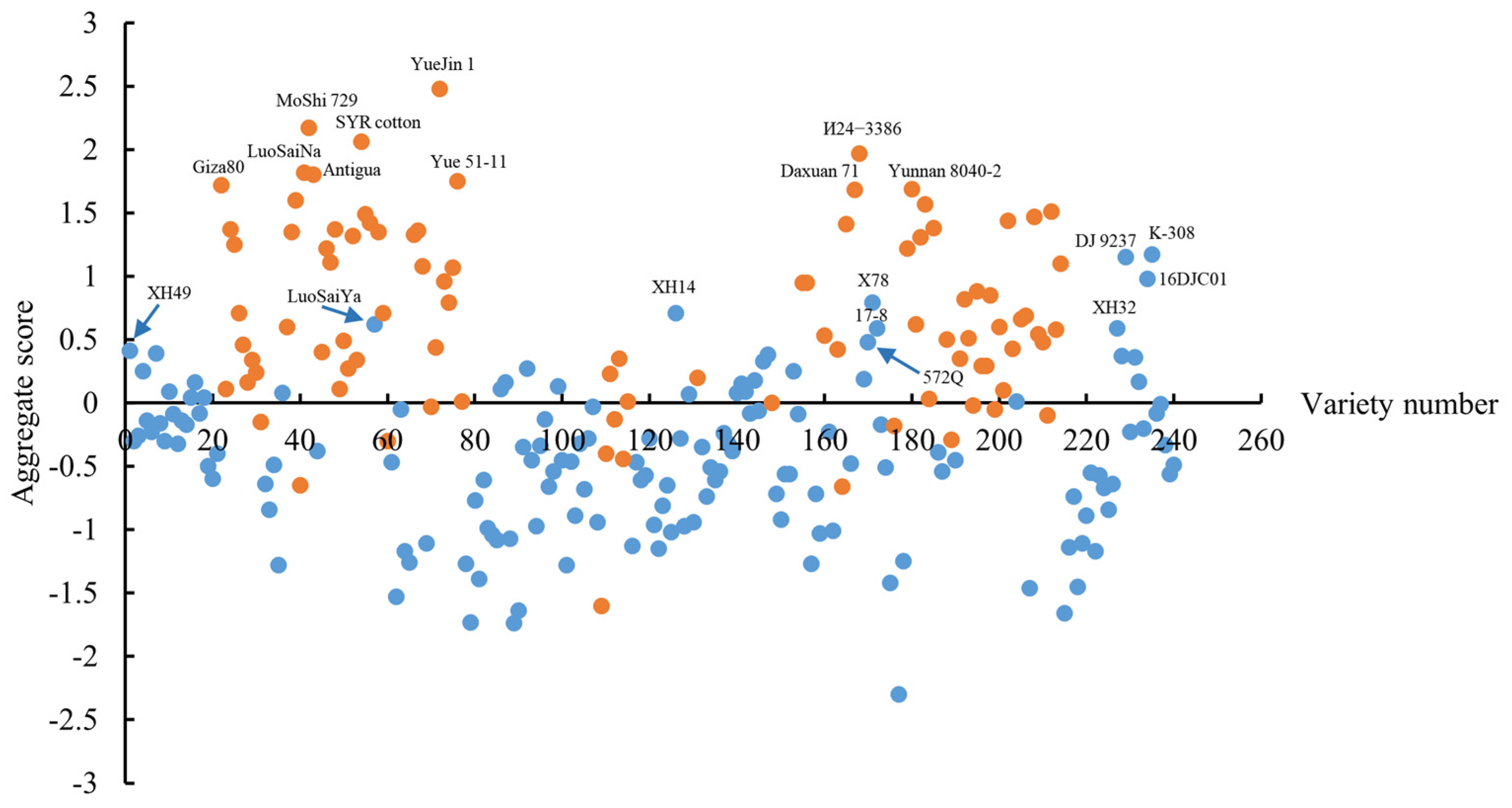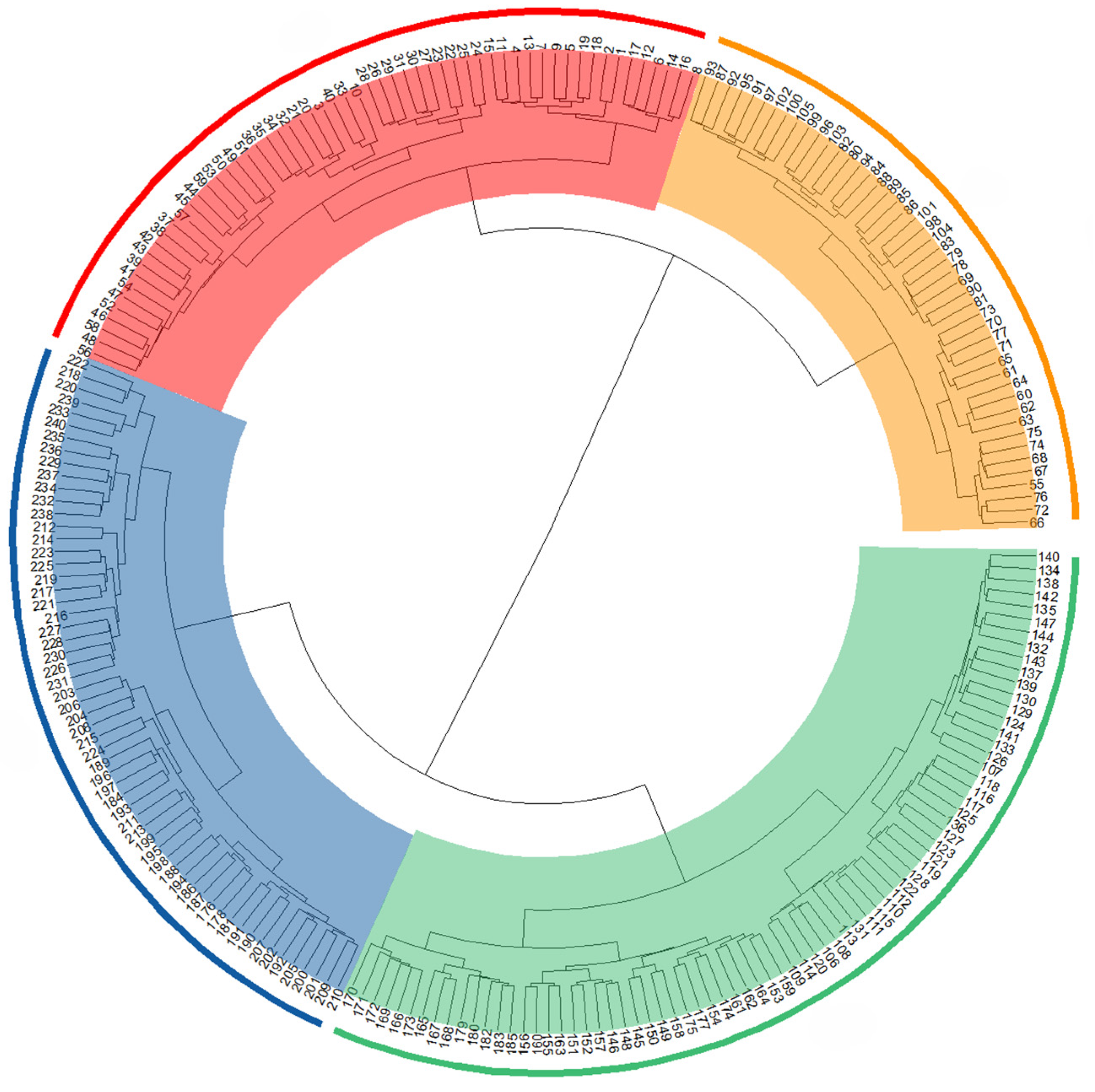Evaluation of Quality Traits in Relation to Mechanical Harvesting for Screening Excellent Materials in Gossypium barbadense L. Germplasm Resources
Abstract
:1. Introduction
2. Materials and Methods
2.1. Experimental Materials
2.2. Field Management
2.3. Data Collection
2.4. Data Analysis
3. Results and Discussion
3.1. Genetic Diversity of Machine-Harvesting Traits of Sea Island Cotton Germplasm Resources
3.2. Correlation Analysis of Machine-Harvesting Traits in Sea Island Cotton
3.3. Principal Component Analysis of Machine-Harvesting Traits in Sea Island Cotton
3.4. Identification of Key Machine-Harvesting Traits and Construction of Regression Models
3.5. Cluster Analysis of Sea Island Cotton Germplasm Resources
4. Conclusions
Author Contributions
Funding
Institutional Review Board Statement
Data Availability Statement
Acknowledgments
Conflicts of Interest
References
- Qin, Y.; Sun, M.; Li, W.; Xu, M.; Shao, L.; Liu, Y.; Zhao, G.; Liu, Z.; Xu, Z.; You, J. Single-cell RNA-seq reveals fate determination control of an individual fiber cell initiation in cotton (Gossypium hirsutum). Plant Biotechnol. J. 2022, 20, 2372–2388. [Google Scholar] [CrossRef]
- Fang, L.; Zhao, T.; Hu, Y.; Si, Z.; Zhu, X.; Han, Z.; Liu, G.; Wang, S.; Ju, L.; Guo, M. Divergent improvement of two cultivated allotetraploid cotton species. Plant Biotechnol. J. 2021, 19, 1325–1336. [Google Scholar] [CrossRef]
- Su, X.; Zhu, G.; Song, X.; Xu, H.; Li, W.; Ning, X.; Chen, Q.; Guo, W. Genome-wide association analysis reveals loci and candidate genes involved in fiber quality traits in sea island cotton (Gossypium barbadense). BMC Plant Biol. 2020, 20, 289. [Google Scholar] [CrossRef]
- Yu, J.; Zhang, K.; Li, S.; Yu, S.; Zhai, H.; Wu, M.; Li, X.; Fan, S.; Song, M.; Yang, D. Mapping quantitative trait loci for lint yield and fiber quality across environments in a Gossypium hirsutum × Gossypium barbadense backcross inbred line population. Theor. Appl. Genet. 2013, 126, 275–287. [Google Scholar] [CrossRef]
- Ma, L.; Zhao, Y.; Wang, Y.; Shang, L.; Hua, J. QTLs Analysis and Validation for Fiber Quality Traits Using Maternal Backcross Population in Upland Cotton. Front. Plant Sci. 2017, 8, 2168. [Google Scholar] [CrossRef]
- Hong, M.; Zhang, L.; Chen, J.; Lu, Z.; Fan, A.; Tursun, T.; Ma, Z.; Xie, L. Practice and Thinking on Mechanical Harvest of Long Staple Cotton in Xinjiang. China Cotton 2020, 47, 8–10. [Google Scholar] [CrossRef]
- Heinicke, C.; Grove, W.A. “Machinery Has Completely Taken Over”: The Diffusion of the Mechanical Cotton Picker, 1949–1964. J. Interdiscip. Hist. 2008, 39, 65–96. [Google Scholar] [CrossRef]
- Wu, J.; Chen, X. Present situation, problems and countermeasures of cotton production mechanization development in Xinjiang Production and Construction Corps. J. Agric. Eng. 2015, 31, 6. [Google Scholar]
- Su, J.; Ma, Q.; Li, M.; Hao, F.; Wang, C. Multi-Locus Genome-Wide Association Studies of Fiber-Quality Related Traits in Chinese Early-Maturity Upland Cotton. Front. Plant Sci. 2018, 9, 1169. [Google Scholar] [CrossRef]
- Zhang, T.; Hu, Y.; Jiang, W.; Fang, L.; Guan, X.; Chen, J.; Zhang, J.; Saski, C.A.; Scheffler, B.E.; Stelly, D.M. Sequencing of allotetraploid cotton (Gossypium hirsutum L. acc. TM-1) provides a resource for fiber improvement. Nat. Biotechnol. 2015, 33, 531–537. [Google Scholar] [CrossRef]
- Kong, Q. The analysis of comparative advantage of production situation for sea island cotton (G. barbadense L.) in China. China Cotton 2002, 29, 19–23. [Google Scholar] [CrossRef]
- Qi, H.; Wang, N.; Qiao, W.; Xu, Q.; Zhou, H.; Shi, J.; Yan, G.; Huang, Q. Construction of a high-density genetic map using genotyping by sequencing (GBS) for quantitative trait loci (QTL) analysis of three plant morphological traits in upland cotton (Gossypium hirsutum L.). Euphytica 2017, 213, 83. [Google Scholar] [CrossRef]
- Shi, J.; Wang, N.; Zhou, H.; Xu, Q.; Yan, G. Transcriptome analyses provide insights into the homeostatic regulation of axillary buds in upland cotton (G. hirsutum L.). BMC Plant Biol. 2020, 20, 228. [Google Scholar] [CrossRef] [PubMed]
- Chandel, R.; Sharma, K. Multiple Attributed Parametric Review Study on Mechanical Cotton (Gossypium hirsutum L.) Harvesters. J. Agric. Sci. 2022, 142, 122. [Google Scholar] [CrossRef]
- Cheng, X.; Feng, Y.; Chen, D.; Luo, C.; Yu, X.; Huang, C. Evaluation of Rosa germplasm resources and analysis of floral fragrance components in R. rugosa. Front. Plant Sci. 2022, 13, 1026763. [Google Scholar] [CrossRef] [PubMed]
- Egan, L.M.; Conaty, W.C.; Stiller, W.N. Core Collections: Is There Any Value for Cotton Breeding? Front. Plant Sci. 2022, 13, 895155. [Google Scholar] [CrossRef]
- Ferguson, A.R. The need for characterization and evaluation of germplasm: Kiwifruit as an example. Euphytica 2007, 154, 371–382. [Google Scholar] [CrossRef]
- Khan, A.S.; Ali, S.; Khan, I.A. Morphological and molecular characterization and evaluation of mango germplasm: An overview. Sci. Hortic. 2015, 194, 353–366. [Google Scholar] [CrossRef]
- Rodríguez, V.M.; Romay, M.C.; Ordás, A.; Revilla, P. Evaluation of European maize (Zea mays L.) germplasm under cold conditions. Genet. Resour. Crop Evol. 2010, 57, 329–335. [Google Scholar] [CrossRef]
- Yan, W.; Rutger, J.N.; Bryant, R.J.; Bockelman, H.E.; Fjellstrom, R.G.; Chen, M.H.; Tai, T.H.; McClung, A.M. Development and Evaluation of a Core Subset of the USDA Rice Germplasm Collection. Crop Sci. 2007, 47, 869–876. [Google Scholar] [CrossRef]
- Upadhyaya, H.D.; Swamy, B.P.M.; Goudar, P.V.K.; Kullaiswamy, B.Y.; Singh, S. Identification of diverse groundnut germplasm through multienvironment evaluation of a core collection for Asia. Field Crop Res. 2005, 93, 293–299. [Google Scholar] [CrossRef]
- Song, Q.; Liu, C.; Bachir, D.G.; Chen, L.; Hu, Y. Drought resistance of new synthetic hexaploid wheat accessions evaluated by multiple traits and antioxidant enzyme activity. Field Crop Res. 2017, 210, 91–103. [Google Scholar] [CrossRef]
- Huang, K.; Dai, X.; Xu, Y.; Dang, S.; Shi, T.; Sun, J.; Wang, K. Relation between level of autumn dormancy and salt tolerance in lucerne (Medicago sativa). Crop Pasture Sci. 2018, 69, 194. [Google Scholar] [CrossRef]
- Tian, Z.; Yang, Y.; Wang, F. A comprehensive evaluation of heat tolerance in nine cultivars of marigold. Hortic. Environ. Biotechnol. 2015, 56, 749–755. [Google Scholar] [CrossRef]
- Li, X.; Ma, H.; Wang, L.; Aimerjiang, A.; Guo, R.; Zhong, J.; Ou, H.; Dai, L.; Zhang, Y.; Xi, Y. Effects of spraying different times and dosages of defoliants on defoliation and ripening of long staple cotton in Xinjiang. China Cotton 2022, 49, 6–9. [Google Scholar] [CrossRef]
- Chen, J.; Zhang, L.; Hong, M.; Fan, A.; Tursun, T.; Ma, Z.; Xie, L. The Suitable for Integrated Mechanically Harvested Cultivation Technical of Long-fiber Cotton in Xinjiang. Cotton Sci. 2021, 43, 64–68. [Google Scholar]
- Zhang, L.; Fan, A.; Hong, M.; Ma, Z.; Chen, J.; Zhao, S.; Zheng, K.; Telson, T. Genetic diversity analysis of 647 sea island cotton germplasm resources. J. Plant Genet. Resour. 2023, 24, 307–324. [Google Scholar] [CrossRef]
- Dai, P.; Sun, J.; He, S.; Wang, L.; Jia, Y.; Pan, Z.; Pang, B.; Du, X.; Wang, Q. Comprehensive evaluation and genetic diversity analysis of phenotypic traits of core collection in upland cotton. Sci. Agric. Sin. 2016, 49, 3694–3708. [Google Scholar] [CrossRef]
- Martínez-Castillo, J.; Colunga-GarcíaMarín, P.; Zizumbo-Villarreal, D. Genetic erosion and in situ conservation of Lima bean (Phaseolus lunatus L.) landraces in its Mesoamerican diversity center. Genet. Resour. Crop Evol. 2008, 55, 1065–1077. [Google Scholar] [CrossRef]
- Pfeiffer, V.W.; Ford, B.M.; Housset, J.; McCombs, A.; Blanco Pastor, J.L.; Gouin, N.; Manel, S.; Bertin, A. Partitioning genetic and species diversity refines our understanding of species–genetic diversity relationships. Ecol. Evol. 2018, 8, 12351–12364. [Google Scholar] [CrossRef] [PubMed]
- Rahman, M.U.; Shaheen, T.; Tabbasam, N.; Iqbal, M.A.; Ashraf, M.; Zafar, Y.; Paterson, A.H. Cotton genetic resources. A review. Agron. Sustain. Dev. 2012, 32, 419–432. [Google Scholar] [CrossRef]
- Pan, Z.; He, S.; Jia, Y.; Podolnaya, L.P.; Sun, J.; Wang, L.; Du, X. Genetic Diversity Analysis of the Sea Island Cotton (Gossypium barbadense L.) Mostly from Former USSR Using SSR Markers. J. Plant Genet. Resour. 2014, 15, 399–404. [Google Scholar] [CrossRef]
- Li, J. Loci Associated with Defoliant Sensitivity of Upland Cotton were Identified by Association Analysis. Master’s Thesis, Tarim University, Alar, China, 2021. [Google Scholar]
- Wang, T.; Zhou, Y.; Liu, C.; Li, J.; He, L. Screening of Upland Cotton Germplasm Resources Which Are Sensitive to Defoliant in Southern Xinjiang. Xinjiang Agric. Sci. 2019, 56, 2189–2198. [Google Scholar] [CrossRef]
- Yu, H. Genetic Diversity and Genome-Wide Association Analysis of Fiber Quality and Yield Traits of Self-Bred Island Cotton Cultivars in Xinjiang. Master’s Thesis, Zhejiang University, Hangzhou, China, 2019. [Google Scholar]
- Baldovin, M.; Cecconi, F.; Vulpiani, A. Understanding causation via correlations and linear response theory. Phys. Rev. Res. 2020, 2, 043436. [Google Scholar] [CrossRef]
- Wang, J.; Zhang, Z.; Zhang, N.; Liang, Y.; Gong, Z.; Wang, J.; Ditta, A.; Sang, Z.; Li, X.; Zheng, J. The Correlation of Machine-Picked Cotton Defoliant in Different Gossypium hirsutum Varieties. Agronomy 2023, 13, 2151. [Google Scholar] [CrossRef]
- Li, L. Effects of Row Spacing on Canopy Microenvironment and Yield Formation of Cotton of Different Plant Types. Master’s Thesis, Xinjiang Agricultural University, Urumqi, China, 2021. [Google Scholar]
- Molania, R.; Foroutan, M.; Gagnon-Bartsch, J.A.; Gandolfo, L.C.; Jain, A.; Sinha, A.; Olshansky, G.; Dobrovic, A.; Papenfuss, A.T.; Speed, T.P. Removing unwanted variation from large-scale RNA sequencing data with PRPS. Nat. Biotechnol. 2022, 41, 82–95. [Google Scholar] [CrossRef] [PubMed]
- Wold, S.; Esbensen, K.; Geladi, P. Principal component analysis. Chemom. Intell. Lab. 1987, 2, 37–52. [Google Scholar] [CrossRef]
- Wang, X.; Xing, A.; Yang, R.; He, S.; Jia, Y.; Pan, Z.; Wang, L.; Du, X.; Song, X. Comprehensive Evaluation of Phenotypic Characters of Nature Population in Upland Cotton. Sci. Agric. Sin. 2022, 55, 1082–1094. [Google Scholar] [CrossRef]
- Zhao, N.; Wang, W.; Jiang, K.; Grover, C.E.; Cheng, C.; Pan, Z.; Zhao, C.; Zhu, J.; Li, D.; Wang, M. A Calmodulin-Like Gene (GbCML7) for Fiber Strength and Yield Improvement Identified by Resequencing Core Accessions of a Pedigree in Gossypium barbadense. Front. Plant Sci. 2022, 12, 815648. [Google Scholar] [CrossRef]
- Zhang, H.; Jiang, C.; Yin, D.; Dong, J.; Ren, Q.; Zhao, X.; Zhong, C.; Wang, X.; Yu, H. Establishment of comprehensive evaluation system for cold tolerance and screening of cold-tolerance germplasm in peanut. Acta Agron. Sin. 2021, 47, 1753–1767. [Google Scholar] [CrossRef]
- Chen, X. Study on Comprehensive Evaluation of Mechanical Performance of Different Cotton Varieties in Northern Xinjiang. Master’s Thesis, Xinjiang Agricultural University, Urumqi, China, 2020. [Google Scholar]






| Traits | Mean | Max | Min | Range | SD | CV (%) | H′ |
|---|---|---|---|---|---|---|---|
| PH | 86.38 | 123.92 | 47.72 | 76.2 | 15.11 | 17.49 | 2.07 |
| SNB | 18.81 | 38.58 | 9.14 | 29.44 | 5.12 | 27.21 | 2 |
| SBN | 4.8 | 8.6 | 2.7 | 5.9 | 1.1 | 22.87 | 2 |
| MLB | 12.21 | 30.22 | 4.52 | 25.7 | 6.45 | 52.77 | 1.71 |
| AFBM | 56.28 | 79.6 | 29.6 | 50 | 10.27 | 18.25 | 2.07 |
| LLFB | 12.25 | 26.56 | 4.3 | 22.26 | 5.85 | 47.75 | 1.78 |
| ALFB | 70.62 | 107 | 38.4 | 68.6 | 10.58 | 14.98 | 2.05 |
| ULIA | 80.25 | 103.2 | 51.6 | 51.6 | 8.39 | 10.46 | 2 |
| MLIA | 83.31 | 112.4 | 60 | 52.4 | 7.9 | 9.49 | 2.04 |
| LLIA | 93.99 | 121.2 | 56.4 | 64.8 | 10.89 | 11.59 | 2.04 |
| NB | 13.86 | 38.4 | 5.6 | 32.8 | 7.48 | 53.98 | 1.57 |
| Fv/F0 | 3.34 | 5.29 | 1.37 | 3.92 | 0.66 | 19.67 | 2.06 |
| Fv/Fm | 0.76 | 0.84 | 0.56 | 0.28 | 0.04 | 5.42 | 1.98 |
| 5 d DR | 0.63 | 0.93 | 0.23 | 0.7 | 0.15 | 24.43 | 2.05 |
| 10 d DR | 0.79 | 1 | 0.35 | 0.65 | 0.11 | 14.4 | 2.01 |
| 15 d DR | 0.88 | 1 | 0.5 | 0.5 | 0.09 | 9.69 | 1.94 |
| 5 d HGY | 0.29 | 0.77 | 0 | 0.77 | 0.16 | 55.36 | 1.92 |
| 10 d HGY | 0.19 | 0.65 | 0 | 0.65 | 0.12 | 64.08 | 1.93 |
| 15 d HGY | 0.13 | 0.5 | 0 | 0.5 | 0.09 | 66.96 | 1.94 |
| Eigenvectors | Factor 1 | Factor 2 | Factor 3 | Factor 4 | Factor 5 | Factor 6 |
|---|---|---|---|---|---|---|
| PH | 0.15 | 0.01 | −0.09 | 0.26 | 0.57 | 0.28 |
| SNB | 0.25 | 0.23 | 0.04 | −0.01 | 0.47 | 0.13 |
| SBN | 0.25 | 0.3 | −0.03 | 0.05 | 0.29 | −0.02 |
| MBL | 0.21 | 0.39 | 0.04 | −0.16 | −0.08 | −0.16 |
| AFBM | 0.07 | 0.12 | 0.31 | −0.36 | −0.17 | 0.33 |
| LLFB | 0.23 | 0.38 | 0.04 | −0.19 | −0.05 | −0.13 |
| ALFB | −0.05 | 0.02 | 0.25 | −0.31 | −0.09 | 0.62 |
| ULIA | −0.02 | −0.19 | 0.47 | 0 | 0.22 | −0.08 |
| MLIA | 0.05 | −0.11 | 0.52 | −0.03 | 0.16 | −0.24 |
| LLIA | 0.01 | −0.17 | 0.46 | −0.03 | 0.09 | −0.25 |
| NB | 0.25 | 0.33 | 0.04 | −0.13 | −0.08 | −0.17 |
| Fv/F0 | 0.03 | 0.24 | 0.24 | 0.55 | −0.24 | 0.12 |
| Fv/Fm | 0.02 | 0.22 | 0.24 | 0.56 | −0.27 | 0.13 |
| 5 d DR | 0.33 | −0.13 | −0.03 | −0.06 | −0.22 | −0.04 |
| 10 d DR | 0.34 | −0.23 | 0 | 0.06 | −0.09 | 0.08 |
| 15 d DR | 0.33 | −0.27 | −0.04 | 0.05 | −0.02 | 0.06 |
| 5 d HGY | −0.35 | 0.1 | 0.04 | 0.02 | 0.22 | 0.06 |
| 10 d HGY | −0.35 | 0.19 | 0 | −0.07 | 0.05 | −0.06 |
| 15 d HGY | −0.32 | 0.26 | 0.06 | −0.05 | 0.02 | −0.06 |
| CV | 5.87 | 3.63 | 2.33 | 1.78 | 1.43 | 1.03 |
| CR (%) | 30.89 | 19.09 | 12.24 | 9.36 | 7.5 | 5.41 |
| CCR (%) | 30.89 | 49.98 | 62.22 | 71.57 | 79.07 | 84.48 |
| Phenotype | Group I | Group Ⅱ | Group Ⅲ | Group Ⅳ |
|---|---|---|---|---|
| PH | 84.95 b | 95.8 a | 80.41 b | 84.71 b |
| SNB | 17.36 b | 20.62 a | 18.3 b | 18.71 b |
| SBN | 4.47 b | 5.62 a | 4.77 b | 4.41 b |
| MBL | 10.60 b | 14.38 a | 13.34 a | 10.68 b |
| AFBM | 54.44 b | 50.82 c | 57.05 b | 60.98 a |
| LLFB | 10.34 c | 14.32 a | 12.88 ab | 11.36 bc |
| ALFB | 71.08 a | 63.54 b | 74.61 a | 72.65 a |
| ULIA | 81.12 a | 76.39 b | 80.63 a | 82.35 a |
| MLIA | 83.86 a | 80.68 b | 83.08 ab | 85.15 a |
| LLIA | 95.27 a | 88.68 b | 94.97 a | 96.49 a |
| NB | 13.20 b | 16.76 a | 13.48 b | 12.34 b |
| Fv/F0 | 3.51 ab | 3.30 b | 3.65 a | 3.04 c |
| Fv/Fm | 0.77 ab | 0.76 bc | 0.78 a | 0.74 c |
| 5 d DR | 0.58 b | 0.66 a | 0.61 b | 0.64 b |
| 10 d DR | 0.74 b | 0.81 a | 0.78 ab | 0.81 a |
| 15 d DR | 0.85 b | 0.91 a | 0.87 b | 0.90 a |
| 5 d HGY | 0.37 a | 0.25 b | 0.31 b | 0.27 b |
| 10 d HGY | 0.25 a | 0.15 c | 0.21 ab | 0.17 bc |
| 15 d HGY | 0.17 a | 0.11 b | 0.15 a | 0.11 b |
Disclaimer/Publisher’s Note: The statements, opinions and data contained in all publications are solely those of the individual author(s) and contributor(s) and not of MDPI and/or the editor(s). MDPI and/or the editor(s) disclaim responsibility for any injury to people or property resulting from any ideas, methods, instructions or products referred to in the content. |
© 2024 by the authors. Licensee MDPI, Basel, Switzerland. This article is an open access article distributed under the terms and conditions of the Creative Commons Attribution (CC BY) license (https://creativecommons.org/licenses/by/4.0/).
Share and Cite
Lin, F.; Wang, M.; Zhao, N.; Zhang, Y.; Wang, W.; Yang, J.; Wan, S.; Li, J.; Aierxi, A.; Chen, G.; et al. Evaluation of Quality Traits in Relation to Mechanical Harvesting for Screening Excellent Materials in Gossypium barbadense L. Germplasm Resources. Agronomy 2024, 14, 891. https://doi.org/10.3390/agronomy14050891
Lin F, Wang M, Zhao N, Zhang Y, Wang W, Yang J, Wan S, Li J, Aierxi A, Chen G, et al. Evaluation of Quality Traits in Relation to Mechanical Harvesting for Screening Excellent Materials in Gossypium barbadense L. Germplasm Resources. Agronomy. 2024; 14(5):891. https://doi.org/10.3390/agronomy14050891
Chicago/Turabian StyleLin, Feng, Meng Wang, Nan Zhao, Yubo Zhang, Weiran Wang, Jing Yang, Sumei Wan, Jianping Li, Alifu Aierxi, Guodong Chen, and et al. 2024. "Evaluation of Quality Traits in Relation to Mechanical Harvesting for Screening Excellent Materials in Gossypium barbadense L. Germplasm Resources" Agronomy 14, no. 5: 891. https://doi.org/10.3390/agronomy14050891








